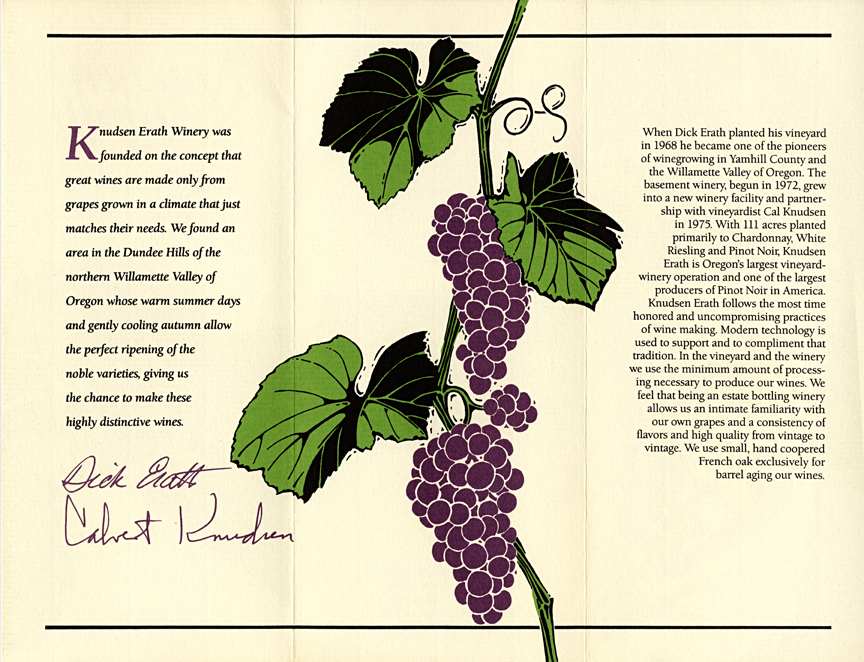- Catalog No. —
- ba018648
- Date —
- October 1989
- Era —
- 1981-Present (Recent Oregon History)
- Themes —
- Agriculture and Ranching, Government, Law, and Politics, Trade, Business, Industry, and the Economy
- Credits —
- Business Collection, Mss 1510, Oregon Historical Society Research Library
- Regions —
- Willamette Basin
- Author —
- Knudsen Erath Winery
Knudsen Erath Brochure
This 1989 brochure advertises one of Oregon's oldest and most successful wineries, Knudsen Erath. Dick Erath established the winery in 1968, and in 1975 he was joined by Calvert Knudsen, who stayed with the business for about twelve years. The winery, located in Dundee in Yamhill County, is one of hundreds that now operate across the state, contributing millions of dollars to the economy and winning international recognition.
The wine industry has grown exponentially since Erath began his operation in the late 1960s. Grape cultivation and wine crafting, however, has had a long history in Oregon. Some of Oregon's earliest settlers brought vine cuttings to the Willamette Valley. An 1860 census of agriculture noted that 2,603 gallons of wine were produced in Oregon, and an 1880 national census of wine listed 15,000 gallons produced in Jackson County alone.
In 1904, German immigrant Ernst Reuter, who lived near Forest Grove, won a silver medal for his wine at the St. Louis Exhibition. Grape production actually increased in Oregon during Prohibition, when winemakers worked in basements and private bathrooms. By 1938, twenty-eight wineries were operating in Oregon, producing over one million gallons of wine. Between 1938 and the late 1950s, however, wine production decreased as California became the nation's leading supplier of wine.
An increased demand for table wine in the 1960s led entrepreneurs to consider planting vineyards wherever south-facing hillsides take advantage of the sun's light in the Willamette and other valleys in Oregon. The elevation range, average rainfall, and soil drainage of much of the Willamette Valley is similar to that of the Burgundy region of France. Recognizing that similarity, Dick Erath began his venture by growing pinot noir grapes.
As more winegrowers, such as David Lett of Eyrie Vineyards, started growing in the region, researchers at Oregon State University began to aid the industry. In 1968, they planted varieties of grapes in Medford, Aurora, and Corvallis and, in the late 1970s, studied bacteria strains that were particular to Lett's and Erath's wines. Throughout the 1980s, OSU researchers brought different varieties, or "clones," of pinot noir vines into Oregon and tested them. Researchers and growers in Oregon are aided by the Table Wine Research Advisory Board, which was established by the state legislature in 1977, the same year strict wine labeling regulations were adopted by the Oregon Liquor Control Commission.
Today, operators of many Oregon vineyards employ environmental considerations in their work. The Oregon Wine Board lists dozens of vineyards that have been certified by various organizations for their commitment to organic, sustainable farming.
Further reading:
Susan Sokol Blosser, At Home in the Vineyard: Cultivating a Winery, an Industry, and a Life (Berkeley: University of California Press, 2006).
Lisa Shara Hall, Wines of the Pacific Northwest: A Contemporary Guide to the Wines of Washington & Oregon (London: Octopus Publishing Group, 2001).
The Oregon Wine Industry: Historical Perspectives and the Current Production and Cost Situation (Corvallis: Oregon State University Extension Service, January 1984).
Written by Eliza Canty-Jones, © Oregon Historical Society, 2007.
